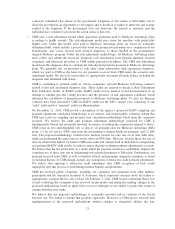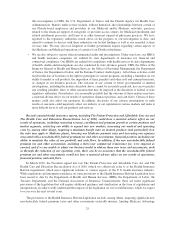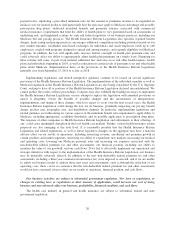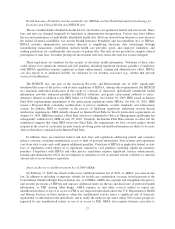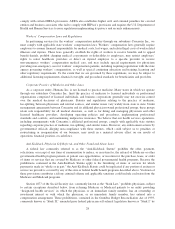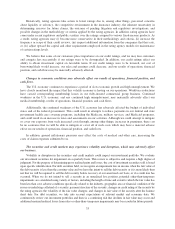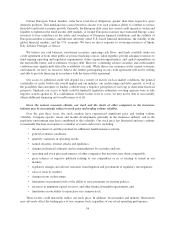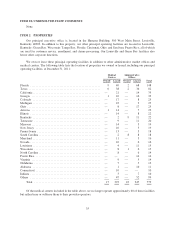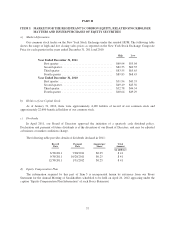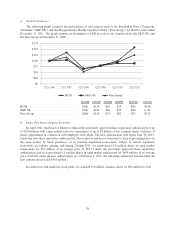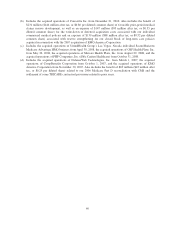Humana 2011 Annual Report Download - page 40
Download and view the complete annual report
Please find page 40 of the 2011 Humana annual report below. You can navigate through the pages in the report by either clicking on the pages listed below, or by using the keyword search tool below to find specific information within the annual report.Although minimum required levels of equity are largely based on premium volume, product mix, and the
quality of assets held, minimum requirements can vary significantly at the state level. Our state regulated
subsidiaries had aggregate statutory capital and surplus of approximately $4.7 billion and $4.3 billion as of
December 31, 2011 and 2010, respectively, which exceeded aggregate minimum regulatory requirements. The
amount of dividends that may be paid to our parent company in 2012 without prior approval by state regulatory
authorities is approximately $970 million in the aggregate. This compares to dividends that were able to be paid
in 2011 without prior regulatory approval of approximately $740 million.
Any failure to manage operating costs could hamper profitability.
The level of our operating costs impacts our profitability. While we proactively attempt to effectively
manage such expenses, increases or decreases in staff-related expenses, additional investment in new products
(including our opportunities in the Medicare programs), greater emphasis on small group and individual health
insurance products, investments in health and well-being product offerings, expansion into new specialty
markets, acquisitions, new taxes and assessments, including the new non-deductible federal premium tax and
other assessments under Health Insurance Reform Legislation, such as the three-year commercial reinsurance
fee, and implementation of regulatory requirements may occur from time to time.
There can be no assurance that we will be able to successfully contain our operating costs in line with our
membership and this may result in a material adverse effect on our results of operations, financial position, and
cash flows.
Any failure by us to manage acquisitions and other significant transactions successfully may have a
material adverse effect on our results of operations, financial position, and cash flows.
As part of our business strategy, we frequently engage in discussions with third parties regarding possible
investments, acquisitions, strategic alliances, joint ventures, and outsourcing transactions and often enter into
agreements relating to such transactions in order to further our business objectives. In order to pursue this
strategy successfully, we must identify suitable candidates for and successfully complete transactions, some of
which may be large and complex, and manage post-closing issues such as the integration of acquired companies
or employees. Integration and other risks can be more pronounced for larger and more complicated transactions,
or if multiple transactions are pursued simultaneously. In 2011, we acquired MD Care, Inc. and Anvita, Inc., and
in 2010, we acquired Concentra Inc. The failure to successfully integrate acquired entities and businesses or
failure to produce results consistent with the financial model used in the analysis of our acquisitions may have a
material adverse effect on our results of operations, financial position, and cash flows. If we fail to identify and
complete successfully transactions that further our strategic objectives, we may be required to expend resources
to develop products and technology internally. We may also be at a competitive disadvantage or we may be
adversely affected by negative market perceptions, any of which may have a material adverse effect on our
results of operations, financial position, and cash flows.
If we fail to develop and maintain satisfactory relationships with the providers of care to our members,
our business may be adversely affected.
We contract with physicians, hospitals and other providers to deliver health care to our members. Our
products encourage or require our customers to use these contracted providers. These providers may share
medical cost risk with us or have financial incentives to deliver quality medical services in a cost-effective
manner.
In any particular market, providers could refuse to contract with us, demand to contract with us, demand
higher payments, or take other actions that could result in higher health care costs for us, less desirable products
for customers and members or difficulty meeting regulatory or accreditation requirements. In some markets,
some providers, particularly hospitals, physician specialty groups, physician/hospital organizations, or multi-
specialty physician groups, may have significant market positions and negotiating power. In addition, physician
30





